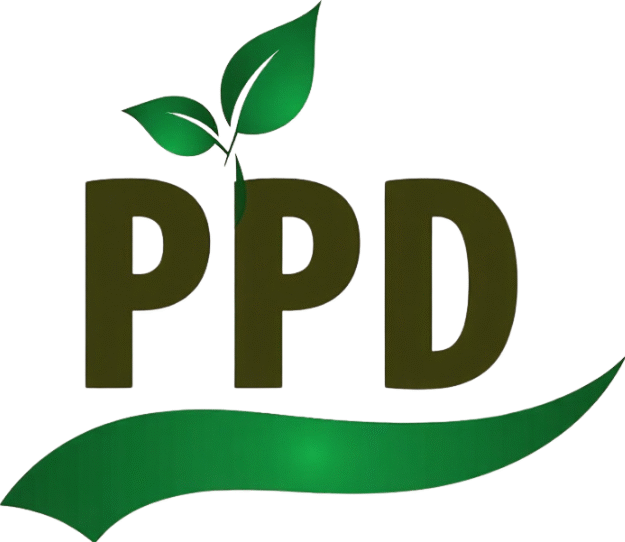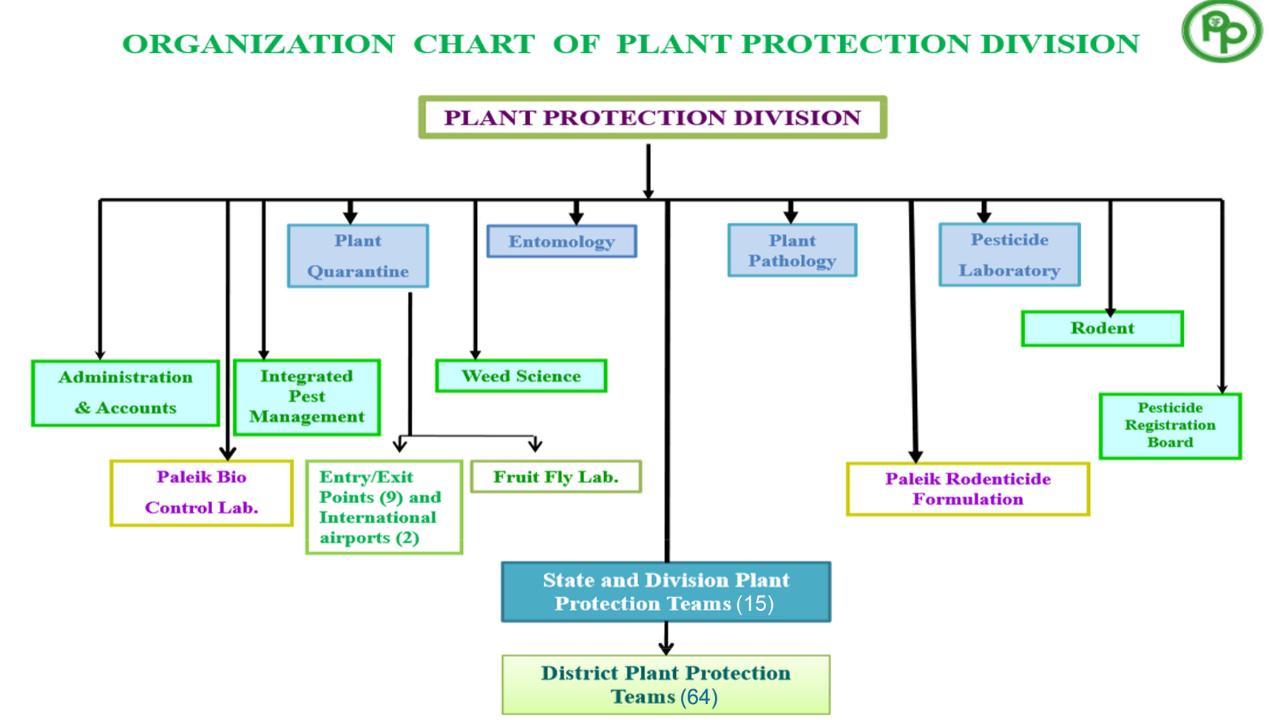
The health of Myanmar’s crops—and, by extension, its food security and agricultural trade—depends heavily on one key agency: the Plant Protection Division (PPD) under the Department of Agriculture (DOA), Ministry of Agriculture, Livestock and Irrigation (MOALI). This division plays a crucial role in pest surveillance, quarantine enforcement, farmer training, and emergency response against crop threats. But behind these functions is a well-structured, coordinated organization with specific roles and responsibilities.
This article explores the organizational structure of PPD, outlining its key sections, their responsibilities, and how they function in unison to protect the nation’s agriculture.
Overview of the Plant Protection Division (PPD)
The PPD is the primary national authority for plant health, overseeing preventive and corrective measures against pests and plant diseases across Myanmar. It bridges science, field operations, regulatory control, and international compliance.
The division is composed of central units, technical sections, and regional field offices, each with defined functions and communication channels.
Core Objectives of PPD
- Prevent introduction and spread of pests and plant diseases.
- Promote sustainable pest management practices (e.g., Integrated Pest Management – IPM).
- Ensure compliance with international phytosanitary standards.
- Conduct training and public awareness for farmers and stakeholders.
- Support research and innovation in plant protection technologies.
Organizational Structure of the Plant Protection Division
The Plant Protection Division is divided into several functional units, each playing a specialized role. These units operate under the leadership of a Director, assisted by Deputy Directors and Section Heads.
1. Administrative and Planning Unit
- Coordinates internal logistics, budgeting, staff assignments, and reporting to DOA headquarters.
- Manages national-level planning and project implementation.
2. Pest Surveillance and Forecasting Section
- Conducts nationwide monitoring of pest and disease occurrence.
- Uses data and GIS tools for pest outbreak prediction and early warnings.
- Collaborates with township-level agriculture offices for reporting.
3. Plant Quarantine Section (PQS)
- Oversees import/export inspections of plant materials.
- Issues Phytosanitary Certificates for exporters.
- Prevents entry of exotic pests through border surveillance at ports, airports, and checkpoints.
4. Pest Control and IPM Section
- Designs and implements pest control programs, emphasizing environmentally sound IPM strategies.
- Conducts trials on biopesticides and mechanical control methods.
- Trains extension workers and farmers on safe pest management.
5. Laboratory and Diagnostics Section
- Runs diagnostic laboratories for pest identification and residue testing.
- Supports evidence-based decision-making in outbreak scenarios.
- Assesses pesticide formulations and biocontrol agent quality.
6. Extension, Training, and Public Awareness Section
- Develops and disseminates farmer-friendly educational materials.
- Organizes Farmer Field Schools (FFS), workshops, and demonstrations.
- Coordinates mass media campaigns during major pest outbreaks.
7. Emergency Response Task Force
- Operates during pest emergencies such as locust or Fall Armyworm infestations.
- Mobilizes regional officers and coordinates national-level containment plans.
- Works closely with General Administration Department (GAD) and local authorities.
Field-Level Implementation
PPD’s national strategies are implemented through Regional Plant Protection Offices, which are aligned with the country’s agro-ecological zones. These include:
- State and Regional PPD Offices: Oversee district and township-level activities.
- Township Agricultural Offices: Conduct field visits, pest scouting, and farmer training.
- Mobile Plant Protection Teams: Deployed during emergencies for fast response and technical support.
Inter-Unit Coordination Mechanism
Each PPD section, while specialized, coordinates through weekly review meetings, joint reporting systems, and digital communication platforms to ensure coherence in planning and action. The Division also holds Annual Plant Health Conferences to review progress, share research findings, and revise action plans.
Key Roles and Responsibilities of PPD Units
| Section | Key Responsibilities |
|---|---|
| Pest Surveillance & Forecasting | Pest mapping, data collection, risk alerts |
| Plant Quarantine Section | Border inspections, phytosanitary certification |
| IPM and Pest Control | Pest control plans, eco-friendly techniques, IPM promotion |
| Lab & Diagnostics | Pest diagnostics, pesticide quality control, lab support |
| Extension and Training | Farmer education, training materials, FFS programs |
| Emergency Response Unit | Rapid pest containment, outbreak coordination |
Achievements of the PPD Structure
- Efficient Emergency Response: Fast deployment during outbreaks (e.g., locusts, Fall Armyworm).
- Stronger Farmer Outreach: Expansion of IPM training in rural communities.
- Improved Phytosanitary Standards: Compliance with IPPC and ASEAN plant health standards.
- Enhanced Surveillance Network: Real-time data collection from remote township offices.
Challenges Faced
While the organizational structure is robust, some challenges remain:
- Limited Resources: Diagnostic labs and mobility tools are lacking in some remote regions.
- Staff Capacity Gaps: Need for continual training in digital tools and new pest threats.
- Coordination with Other Agencies: Requires more integration with health, customs, and research institutions.
- Climate-Driven Threats: Pest behavior is changing, demanding more adaptive planning.
Reform and Modernization Goals
PPD is currently working on structural improvements to enhance responsiveness and efficiency:
- Digital Integration: Mobile pest reporting apps and cloud-based data systems.
- Infrastructure Upgrades: Lab modernization and GPS-enabled surveillance tools.
- Cross-Sector Linkages: More joint training and data sharing with customs, health, and research bodies.
- Performance Monitoring System: KPIs for each unit to improve accountability.
Overview Table: Organizational Components of PPD
| Unit Name | Focus Area | Lead Role |
|---|---|---|
| Admin and Planning | Logistics, planning, coordination | Division management |
| Surveillance and Forecasting | Pest detection and alerts | Field data and prediction systems |
| Plant Quarantine Section (PQS) | Border biosecurity and certifications | Import/export inspections |
| Pest Control & IPM Section | Management strategies and training | IPM programs and farmer engagement |
| Laboratory and Diagnostics Section | Scientific validation and testing | Pesticide quality and pest ID |
| Extension and Training | Outreach and education | Farmer Field Schools and awareness |
Conclusion
The Plant Protection Division’s structured, multi-functional setup allows Myanmar to mount a dynamic and science-driven defense against crop pests and diseases. With dedicated teams in surveillance, quarantine, pest control, and education, PPD serves as the backbone of the country’s plant health system. As threats become more complex, the continued strengthening of each unit and better integration with national and international systems will be key to long-term success.
Top 3 One-Line FAQs
Q1: What is the main role of Myanmar’s Plant Protection Division?
A: To prevent and manage crop pest and disease threats through surveillance, control, quarantine, and farmer education.
Q2: Which unit of PPD handles plant imports and exports?
A: The Plant Quarantine Section (PQS) manages inspections and phytosanitary certifications.
Q3: How does PPD support farmers directly?
A: Through extension services, Farmer Field Schools, pest advisories, and training on eco-friendly pest management.

